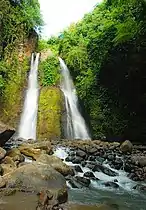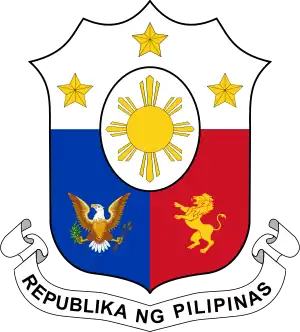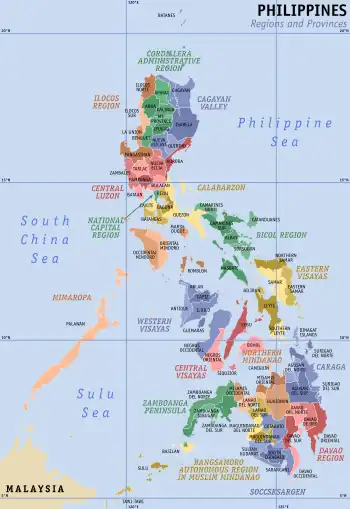Negros
Negros (English: /ˈneɪɡroʊs, ˈnɛɡ-/,[5] UK: /ˈneɪɡrɒs/)[6] is the fourth largest and third most populous island in the Philippines, with a total land area of 13,309 km2 (5,139 sq mi).[7] Negros is one of the many islands of the Visayas, in the central part of the country. The predominant inhabitants of the island region are mainly called Negrenses (locally Negrosanons). As of 2020 census, the total population of Negros is 4,656,945 people.[8]
 Negros island satellite image captured by Sentinel-2 in 2016 | |
 Location in the Philippines | |
| Geography | |
|---|---|
| Location | Southeast Asia |
| Coordinates | 10°N 123°E |
| Archipelago | Visayas |
| Adjacent to | |
| Area | 13,309.60 km2 (5,138.87 sq mi)[1] |
| Area rank | 62nd |
| Coastline | 644.90 km (400.722 mi)[2] |
| Highest elevation | 2,465 m (8087 ft)[3] |
| Highest point | Kanlaon |
| Administration | |
| Region | |
| Provinces | |
| Largest settlement | Bacolod (pop. 600,783) |
| Demographics | |
| Demonym | Negrenses/Negrosanons |
| Population | 4,656,945 (2020)[4] |
| Pop. density | 331.7/km2 (859.1/sq mi) |
| Ethnic groups | Visayans (Hiligaynons and Cebuanos) |
From 2015 to 2017, the whole island was governed as an administrative region officially named the Negros Island Region, which comprised the highly urbanized city of Bacolod and the provinces of Negros Occidental and Negros Oriental, along with its corresponding outlying islands and islets within a total regional area of 13,350.74 km2 (5,154.75 sq mi).[9][10] It was created on May 29, 2015, by virtue of Executive Order No. 183 issued by President Benigno Aquino III.[11][12] On August 9, 2017, the region was dissolved after President Rodrigo Duterte signed Executive Order No. 38, reverting its constituents to their former regions.[13]
History
Precolonial era
Negros was originally called Buglas, an old Hiligaynon word thought to mean "cut off", as it is believed that the island was separated from a larger landmass by rising waters during the last ice age. It was also known as Mamaylan (not to be confused with Himamaylan) and Panilougon among the Cebuano-speaking Visayans.[14] Among its earliest inhabitants were the aboriginal Ata, one of several aboriginal Negrito ethnic groups dispersed throughout Southeast Asia that possesses a unique culture. The westernmost portions of the island soon fell under the nominal rule of the Kedatuan of Madja-as from the neighboring islands of Panay and Guimaras, while the easternmost areas were influenced by the Rajahnate of Cebu from neighboring Cebu Island.
Spanish colonization
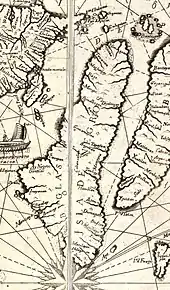
Upon arriving on the island in April 1565, the Spanish colonizers called the land Negros, after the dark-skinned natives they observed. Two of the earliest native settlements, Binalbagan and Ilog, became towns in 1573 and 1584, respectively, while other settlements of the period included Hinigaran, Bago, Marayo (now Pontevedra), Mamalan (now Himamaylan), and Candaguit (now a sitio of San Enrique).
After appointing encomenderos for the island, Miguel López de Legazpi placed Negros under the jurisdiction of the governor of Oton in Panay. In 1734, however, the island became a military district with Ilog as its first capital. The seat of government was later transferred to Himamaylan until Bacolod became the capital in 1849. In 1865, Negros and its outlying minor islands along with Siquijor was converted into a politico-military province.
In 1890, the island was officially partitioned into the present-day provinces of Negros Occidental and Negros Oriental. The Spanish Governor, D. Isidro Castro y Cinceros, surrendered to the Negros Revolutionaries, led by Aniceto Lacson and Juan Araneta, on 6 November 1898.[15]: 520 General Miller appointed Aniceto, Governor of the Island in March 1899.
Negros Revolution and formation of Republic of Negros

From 3 to 6 November 1898, the Negrense peoples rose in revolt against the local Spanish colonial government headed by politico-military governor Colonel Isidro de Castro. The Spaniards decided to surrender upon seeing armed troops marching in a pincer movement towards Bacolod. The revolutionaries, led by General Juan Araneta from Bago and General Aniceto Lacson from Talisay, bore fake arms consisting of rifles carved out of palm fronds and cannons of rolled bamboo mats painted black. By the afternoon of 6 November, Col. de Castro signed the Act of Capitulation, thus ending centuries of Spanish colonial rule in Negros Occidental.
In memory of this event, every November 5 is observed as a special non-working holiday in the province through Republic Act No. 6709, signed by President Corazon Aquino on 10 February 1989.
On 27 November 1898, the Cantonal Republic of Negros unilaterally proclaimed independence, but this was short-lived as the territory became a protectorate of the United States on 30 April 1899. The state was renamed the Republic of Negros (Spanish: República de Negros) on 22 July 1899, and eventually dissolved by the United States and annexed by the U.S. Military Government of the Philippine Islands on 30 April 1901.
The leaders of the short-lived republic were:[16]
- Aniceto Lacson, November 5, 1898 – July 22, 1899 (to November 27, 1898, in Negros Occidental)
- Demetrio Larena, November 24, 1898 – November 27, 1898 (in Negros Oriental)
- President of the Constituent Assembly José Luzuriaga, July 22, 1899 – November 6, 1899
- Secretary of War Juan Araneta
- Civil Governor Melecio Severino, November 6, 1899 – April 30, 1901
- Secretary of Justice Antonio Ledesma Jayme, November 5, 1898 – July 22, 1899
Commonwealth period
From 1914 to 1927, parts of Western Negros hosted several newly established settlements which became cities connected by railroads constructed to flow towards several "sugar centrals" which were processing the extremely sweet raw sugar canes grown in Negros' volcanic soil and farmed by several "Haciendas". These haciendas littered the countryside as the central sugar mills eventually grew to become full pledged towns and cities: chief among which were Ilog, Hinigaran, La Carlota, Silay, Pulupandan, Bacolod, San Carlos and Bais.[17] Western Negros also saw massive immigration from Panay as the Spanish, Chinese, and French mestizos who administered the Haciendas[18] imported laborers from Panay island to foster the farming of Negros' sugar plantations and thereby displacing the Cebuano speaking natives.[19] The east side of Negros was not as thickly settled but became a center of education as[15]: 520 on 9 April 1901, the Second Philippine Commission under the chairmanship of William H. Taft arrived in Dumaguete. Weeks later on 1 May, the civil government under American sovereignty was established, and on 28 August, Dr. David S. Hibbard founded what is now Silliman University the first American school in the Philippines and the entire Asian continent with the help of Meliton Larena as the first Mayor of Dumaguete, as well as Demetrio Larena. Thus, Negros is among the most populous islands in the Philippines and also the one with the most number of component cities.[20]
Post-Commonwealth era
Regions were first formed on September 24, 1972 when the provinces of the Philippines were organized into different 11 regions by Presidential Decree No. 1 as part of the Integrated Reorganization Plan of President Ferdinand Marcos. Negros Occidental was assigned to Western Visayas (Region VI) and Negros Oriental was assigned to Central Visayas (Region VII).
Negros famine
By the time Ferdinand Marcos' second term began, sugar had become a critical Philippine export, responsible for 27% of the county's total dollar earnings.[21] With international sugar prices rising rapidly through the early 1970s, Marcos decided to put domestic and international sugar trading under government control, first through the Philippine Exchange Co. (Philex), and later through the Philippine Sugar Commission (Philsucom) and its trading arm, the National Sugar Trading Corporation (NASUTRA), which were both controlled by Marcos crony Roberto Benedicto.
However, the international price of sugar eventually crashed,[22][23] dramatically hurting the livelihoods of poor farmers. The NASUTRA monopoly forced many sugar planters into bankruptcy or deep in debt. In 1984, over 190,000 sugar workers lost their livelihood,[24][21] and about a million sacadas and their families in Negros suffered in what would later become known as the "Negros Famine."[25]
Author John Silva,[26] who was working with Oxfam at the time, visited Negros and later described the living conditions of thousands of starving and malnourished children:
I drove past the provincial hospital where I first saw hundreds of malnourished children on mats on the floors tended by their mothers, and later, we were in the country through cane fields and small towns remembering the skeletal children being weighed and assessed by our medical team.... There were over 100,000 children in various degree of malnutrition and we started a feeding program for 90,000 of them, hoping to save the worst cases.[26]
The famine in Negros sparked a worldwide firestorm. International relief agencies flew in to conduct feeding programs, local NGOs mobilized relief drives, and members of the Catholic Church likewise pitched in to help.
Locally, social tensions were so high that the Catholic Bishop of Bacolod, Antonio Fortich described the conditions on the island as a "social volcano" ready to explode.[27] This was the situation on September 20, 1985, which marked the date of the Escalante massacre, in which paramilitary forces under the command of Marcos-allied Negros Occidental Governor Armando Gustilo gunned down farmers protesting social conditions on the 13th anniversary of the declaration of Martial Law. An estimated twenty or thirty farmers were killed,[28][29] and thirty more were wounded.[28]
Another consequence of the famine was the dramatic rise of the Marxist-Leninist-Maoist New People’s Army (NPA) presence on Negros island, with Bishop Fortich stating in 1985 that "the NPA has doubled in strength the last year, principally because of the poverty and hunger here."[30]
Negros Island Region

The movement for a single-island region started in the 1980s when officials of both provinces proposed a one-island, one-region unit. Negros Occidental and Negros Oriental are the only provinces in the Philippines situated in the same island but belonging to two different administrative regions with regional offices located in neighboring Panay and Cebu. The movement to unite the two provinces in Negros island was sustained in the 1990s and 2010s.[31]
The campaign for the creation of a region in Negros had gains when President Benigno Aquino III directed the Department of the Interior and Local Government (DILG) to study the establishment of a new region.[32] with the government agency later endorsing the move.[33] NEDA affirmed by saying that its studies show that the proposed region is economically viable.[34]
On May 29, 2015, President Aquino signed Executive Order 183,[35] which created the Negros Island Region. It separated Negros Occidental and its capital Bacolod from Western Visayas (Region VI) and Negros Oriental from Central Visayas (Region VII) to form the island region, which made the total number of regions of the Philippines into 18.[11][12]
Dissolution
On August 9, 2017, President Rodrigo Duterte signed Executive Order No. 38, revoking the Executive Order No. 183 signed by (former) President Benigno Aquino III on May 29 of 2015, due to the reason of the lack of funds to fully establish the NIR according to Benjamin Diokno, the Secretary of Budget and Management. Its dissolution upset the NIR regional officials and provoked strong negative reactions from the Negrenses.[36]
Demographics
| Year | Pop. | ±% p.a. |
|---|---|---|
| 1990 | 3,182,180 | — |
| 1995 | 3,459,433 | +1.58% |
| 2000 | 3,695,811 | +1.43% |
| 2010 | 4,194,525 | +1.27% |
| 2015 | 4,414,131 | +0.98% |
| 2020 | 4,656,945 | +1.06% |
| Source: Philippine Statistics Authority[37] | ||
Geography

Negros is the second largest island in the Visayas (after Samar) and the fourth largest of the Philippines, with a total land area of 13,309.6 square kilometres (5,138.9 sq mi).[1] It is located between the islands of Panay and Guimaras to the west and Cebu to the east, with Siquijor located on the toe of the island and the islands of Bantayan to the north. Politically and linguistically, Negros is divided into two provinces: Negros Occidental and Negros Oriental.
This division of the island, which roughly follows the mountain range in the center of the island, corresponds to the two related linguistic groups. The western half (Occidental) is home to the Hiligaynon Visayan-speaking population while the eastern half (Oriental) is home to the Cebuano Visayan-speaking population. Together, they are all called Negrenses.
Kanlaon Volcano, located in the central-northern part of the island is the third most-active volcano in the Philippines and overlooks bordering communities and the city of Bacolod to the west. It is the highest peak of the whole island and of the Visayas. Other notable peaks on the island are Mount Silay and Mount Mandalagan in Negros Occidental and Mount Talinis (also known as Cuernos de Negros) in Negros Oriental. There are also lakes that dot the island, among the most notable are the Balinsasayao Twin Lakes in Negros Oriental.
The volcanic activity in Negros is harnessed into electricity through two geothermal power plants in the island. One is located in Palinpinon of Valencia in Negros Oriental and the other is in Mailum of Bago in Negros Occidental, but was eventually shut down.
Administrative divisions
The island of Negros is composed of 2 provinces, 1 highly urbanized city, 19 component cities, 38 municipalities and 1,219 barangays. Negros Occidental is designated as part of Western Visayas and Negros Oriental is designated as part of Central Visayas.
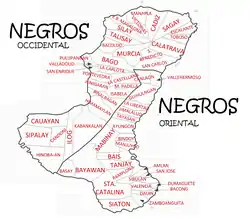
| Province or HUC | Capital | Population (2015)[37] | Area[38] | Density | Cities | Muni. | Barangay | ||||||
|---|---|---|---|---|---|---|---|---|---|---|---|---|---|
| km2 | sq mi | /km2 | /sq mi | ||||||||||
| Negros Occidental | Bacolod | 56.6% | 2,497,261 | 7,802.54 | 3,012.58 | 320 | 830 | 12 | 19 | 601 | |||
| Negros Oriental | Dumaguete | 30.7% | 1,354,995 | 5,385.53 | 2,079.36 | 250 | 650 | 6 | 19 | 557 | |||
| Bacolod | † | — | 12.7% | 561,875 | 162.67 | 62.81 | 3,500 | 9,100 | — | — | 61 | ||
| Total | 4,414,131 | 13,350.74 | 5,154.75 | 330 | 850 | 19 | 38 | 1,219 | |||||
|
† Bacolod is a highly urbanized city; figures are excluded from Negros Occidental. | |||||||||||||
Bacolod is the most populous city on the island and the center of the Bacolod Metropolitan Area (which also contains the cities of Talisay and Silay), as well as the 19th most populous city of the whole Philippines, while Dumaguete is the most densely populated city in the whole region.
Western Visayas is the region with the highest number of cities in the Philippines, within which the province Negros Occidental has the most chartered cities amongst all the provinces in the country.[39] The province comprises 13 cities and 19 municipalities, which are further subdivided into 601 barangays. Although Bacolod serves as the capital, it is governed independently from its corresponding province as a highly urbanized city. Negros Oriental comprises 6 cities and 19 municipalities, with 557 barangays.
| City | Population (2015)[37] | Area[40] | Density | City class | Income class | Province | ||
|---|---|---|---|---|---|---|---|---|
| km2 | sq mi | /km2 | /sq mi | |||||
| Bacolod | 561,875 | 162.67 | 62.81 | 3,500 | 9,100 | Highly urbanized | 1st | Negros Occidental |
| Bago | 170,981 | 401.20 | 154.90 | 430 | 1,100 | Component | 2nd | Negros Occidental |
| Bais | 76,291 | 319.64 | 123.41 | 240 | 620 | Component | 3rd | Negros Oriental |
| Bayawan | 117,900 | 699.08 | 269.92 | 170 | 440 | Component | 2nd | Negros Oriental |
| Cadiz | 154,723 | 524.57 | 202.54 | 290 | 750 | Component | 2nd | Negros Occidental |
| Canlaon | 54,509 | 170.93 | 66.00 | 320 | 830 | Component | 4th | Negros Oriental |
| Dumaguete | 131,377 | 33.62 | 12.98 | 3,900 | 10,000 | Component | 2nd | Negros Oriental |
| Escalante | 94,070 | 192.76 | 74.43 | 490 | 1,300 | Component | 4th | Negros Occidental |
| Guihulngan | 95,969 | 388.56 | 150.02 | 250 | 650 | Component | 5th | Negros Oriental |
| Himamaylan | 106,880 | 367.04 | 141.71 | 290 | 750 | Component | 3rd | Negros Occidental |
| Kabankalan | 181,977 | 697.35 | 269.25 | 260 | 670 | Component | 1st | Negros Occidental |
| La Carlota | 64,469 | 137.29 | 53.01 | 470 | 1,200 | Component | 4th | Negros Occidental |
| Sagay | 146,264 | 330.34 | 127.54 | 440 | 1,100 | Component | 3rd | Negros Occidental |
| San Carlos | 132,536 | 451.50 | 174.33 | 290 | 750 | Component | 2nd | Negros Occidental |
| Silay | 126,930 | 214.80 | 82.93 | 590 | 1,500 | Component | 3rd | Negros Occidental |
| Sipalay | 70,070 | 379.78 | 146.63 | 180 | 470 | Component | 4th | Negros Occidental |
| Talisay | 102,214 | 201.18 | 77.68 | 510 | 1,300 | Component | 4th | Negros Occidental |
| Tanjay | 80,532 | 276.05 | 106.58 | 290 | 750 | Component | 4th | Negros Oriental |
| Victorias | 87,933 | 133.92 | 51.71 | 660 | 1,700 | Component | 1st | Negros Occidental |
Economy
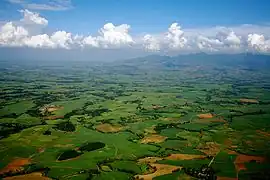
Negros is noted for being the nation's prime producer and exporter of sugar. Sugarcane plantations abound in the agricultural areas of the island. The island also produces cotton and hardwood. Sugar is the biggest industry in the island, followed by organic agricultural products and gamefowl breeding.[41] Its principal sugar-growing region is located in the north and west of the island, stretching from northwest along the coasts of the Visayan Sea and Guimaras Strait, which is one of the nation's principal lowland areas in the Visayas. Negros is now aiming to be the prime producer of organic agricultural produce in Asia.[42][43]
Sugar refining has many by-products such as acetylene, fertilizers and rum. Fishing is the major industry based in Cadiz. There are also a number of fishponds and prawn farming has become a major industry. Bacolod City is the center of commerce and finance in Negros. It is where oil companies, factories, bottling plants, allied industrial businesses, steel fabrication, power generation, agri-businesses, prawn culture and other aqua-culture ventures are found.[44] By November 2016, Negros generated a total net worth of ₱14.355 billion,[45] placing its provinces among the richest in the country.
Tourism
Negros has a lot of tourist attractions. In the city of Silay alone, there are 30 ancestral houses, amongst the most notable is the Balay Negrense. Festivals are also a major tourist attraction in Negros. Among the most notable is the Masskara Festival in the city of Bacolod, which is celebrated during the third week of October, as well as Buglasan Festival in the city of Dumaguete, also held in October.[46] Museums showcase the culture, history and people of Negros, with one example being the Negros Museum, situated behind the Negros Occidental Provincial Capitol Complex.[47] Murcia and Don Salvador Benedicto offer experiences in inland Negros Occidental,[48] the former being known for its Mambukal Resort, while the latter serves as the "Summer Capital of Negros Occidental". Kanlaon Volcano, as well as many other neighbouring peaks, are popular amongst mountain climbers and hikers visiting Negros. The town of Pulupandan, situated in the western tip of Negros, is becoming popular to bird-watching enthusiasts. thanks to its new bird-watching sanctuary.[49]
When it comes to beaches and coastal resorts within the region, the most popular ones are Lakawon Island in Cadiz, Jomabo Island in Escalante, Sipaway/Refugio Island in the city of San Carlos, Sipalay, Hinoba-an and Manjuyod's sand bar. The top attractions in Cauayan are the Punta Bulata White Beach Resort and Danjugan Island, which serves as a major diving spot in Negros Occidental. Also, a marine reserve is established in Sagay City, which protects the marine life and reefs of Carbin and Maca, making it a popular draw for marine life enthusiasts. Dauin is known for its beach resorts and Apo Island, a famous diving spot and marine reserve in Negros Oriental. The city of Dumaguete is popular amongst students, largely because of its presence as a university city in the region. Bais has since then become a tourist spot for whale and dolphin watching,[50] due to its coastline touching the Tañon Strait. Antulang Beach Resort and Tambobo Bay, as well as the inland Lake Balanan serve as three important attractions in the town of Siaton. Situated within the towns of Sibulan, San Jose and Valencia is the Balinsasayao Twin Lakes Natural Park, which serves as an important draw for tourists going to inland Negros Oriental.
Transportation

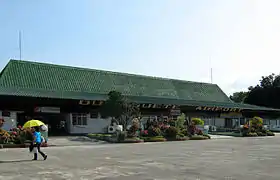
Both provinces of Negros are interconnected by major inter-provincial roads. In Bacolod, there are two main roads, namely Lacson Street to the north and Araneta Street to the south. Cities, especially the provincial capitals of Bacolod and Dumaguete, are being served by jeepneys and taxis. Tricycles are mainly used for short-distance travel, and is common in city barangays, smaller cities and towns. Bus stations are present in major cities and towns within the region. Vallacar Transit Corporation, which operates the Ceres buses, serves the whole island of Negros. There are regularly scheduled fast ferry and roll-on/roll-off services for the island region's coastal cities and towns.
Airports
Currently, there are two airports serving Negros island. The Bacolod-Silay International Airport, located in the city of Silay, serves the general area of Bacolod Metropolitan Area, and is expected to become the primary international gateway to Negros. The Dumaguete-Sibulan Airport, located in the town of Sibulan, serves the general area of Dumaguete and its neighbouring towns. However, a new airport is being planned to be constructed in the town of Bacong, south of Dumaguete, to replace the older airport in Sibulan.[51]
International
Domestic
- Dumaguete-Sibulan Airport
- Kabankalan Airport (under construction)
- Sipalay Airport
Energy
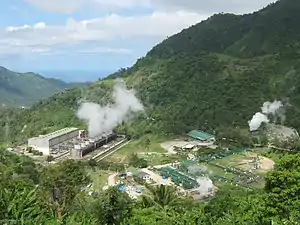
The island is known for using geothermal energy to provide electricity for its inhabitants. In San Carlos, Negros Occidental where energy company San Carlos Solar Energy (SaCaSol) is located, solar energy is being used to power the city and surrounding municipalities. Inland towns and cities of Negros uses hydroelectric power acquired from springs, rivers and waterfalls. Due to the island region's sugarcane-based agriculture, Negros may become the nation's major biofuel producer, with sugarcane being used for ethanol production.[52]
Endangered species
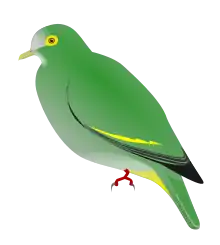
Negros, like the Central Philippines (Visayas) overall, is generally recognized as a top priority area for wildlife conservation, both in terms of numbers of endemic species and severity of threat. More than half of the critically endangered species listed in the Philippines occur in Negros. It is the most threatened area of the Philippines, since it has the least remaining forest cover with just an estimated 3% remaining.[53] It has the highest numbers of severely threatened endemic species and subspecies. Mt. Silay and Mt. Mandalagan are the two mountain peaks in the Northern Negros Natural Park. These mountains have the last remaining old-growth forests.
Negros shares a lot of its fauna with Panay. Due to high amounts of deforestation most of these Western Visayan endemics are threatened. These include the white-winged cuckooshrike, Visayan flowerpecker, flame-templed babbler, writhed-billed hornbill, Visayan tarictic hornbill, Negros bleeding-heart pigeon, Visayan rhabdornis, Negros scops owl, Visayan spotted deer and Visayan warty pig[54] The Negros striped babbler and the possibly extinct Negros fruit dove are only found on the island and nowhere else. Other threatened species include Blue-backed parrot, Pinsker's hawk-eagle, Pink-bellied imperial pigeon, Green-faced parrotfinch and the possibly extinct subspecies of Celestial monarch and Spotted imperial pigeon.[55]
Notable people
- Agustín Montilla y Orendáin, Spanish-Mestizo entrepreneur[56]
References
- "2010 Philippine Yearbook" (PDF). Philippine Yearbook (23rd ed.). Manila, Philippines: Philippine Statistics Authority. ISSN 0116-1520. Retrieved December 14, 2015.
- "Islands of Philippines". Island Directory. United Nations Environment Programme. Retrieved September 18, 2015.
- "Kanlaon Volcano". www.phivolcs.dost.gov.ph. Philippine Institute of Volcanology and Seismology. Retrieved September 18, 2015.
- Census of Population (2020). Table B - Population and Annual Growth Rates by Province, City, and Municipality - By Region. Philippine Statistics Authority. Retrieved 8 July 2021.
- "Definition of NEGROS". www.merriam-webster.com. Retrieved 2023-05-21.
- "Negros". Oxford Dictionaries. Archived from the original on December 8, 2017. Retrieved September 19, 2017.
- "2010 Philippine Yearbook" (PDF). Philippine Yearbook (23rd ed.). Manila, Philippines: Philippine Statistics Authority: 37. ISSN 0116-1520. Retrieved December 14, 2015.
- Census of Population (2015). Highlights of the Philippine Population 2015 Census of Population. Philippine Statistics Authority. Retrieved 20 June 2016.
- Bueza, Michael (June 5, 2015). "FAST FACTS: The Negros Island Region". Rappler. Retrieved June 21, 2015.
- Bustillo, Roy (June 20, 2015). "Negros Island Region is now Region XVIII". CNN Philippines. Retrieved June 21, 2015.
- "Aquino OKs creation of Negros Island Region". Philippine Daily Inquirer. June 5, 2015. Retrieved June 5, 2015.
- "PNoy joins 2 Negros provinces into one region". ABS-CBNnews.com. June 5, 2015. Retrieved June 21, 2015.
- n/a (August 9, 2017). "BREAKING: President Rodrigo Duterte issues E.O. 38, which revokes the creation of Negros Island Region". CNN Philippines. Retrieved August 9, 2017.
- Ocampo, Ambeth (2012). Looking Back: Volume 1. Anvil Publishing, Inc. ISBN 9789712736087.
- Foreman, J., 1906, The Philippine Islands, A Political, Geographical, Ethnographical, Social and Commercial History of the Philippine Archipelago, New York: Charles Scribner's Sons
- "World Statesmen - Philippines - Republic of Negros". Retrieved May 18, 2017.
- McCoy, Alfred W.; C. de Jesus, Ed., eds. (1982). "A Queen Dies Slowly: The Rise and Decline of Iloilo City" in 'Philippine Social History: Global Trade and Local Transformations'. pp. 297–360 – via www.academia.edu.
- Robustiano Echauz, Sketches of the Island of Negros (Athens, Ohio: Ohio University Center for International Studies, Southeast Asia Program, 1978), pp 73-74
- Estadisticas de los Terrenos Agricolas, La Carlota and Hinigaran, Negros Occidental, 1897, Varias Provincias, PNA
- "FAST FACTS: The Negros Island Region". Rappler.
- Ricardo., Manapat (1991). Some are smarter than others : the history of Marcos' crony capitalism. New York: Aletheia Publications. ISBN 9719128704. OCLC 28428684.
- "Martial Law Museum". Retrieved 2018-05-27.
- Branigin, William (1986-03-28). "Marcos Circle Said to Skim $1 Billion From Sugar Sales". The Washington Post. ISSN 0190-8286. Retrieved 2018-05-27.
- "Business in Philippines' sugar capital sours, leaving communists to prosper". Christian Science Monitor. 1985-08-07. ISSN 0882-7729. Retrieved 2018-05-27.
- Quimpo, Susan F. "I saw martial law up close and personal". Retrieved 2018-05-27.
- Silva, John (2016-03-01). "Never forget the famine in Negros". Bantayog ng mga Bayani. Archived from the original on 2019-03-09.
- "Obituary: Antonio Fortich". The Economist. Retrieved 2022-08-14.
- International Labour Organization. "Committee on Freedom of Association Report". Archived from the original on 2007-09-27. Retrieved 2007-05-22.
- Supreme Court of the Philippines. "PHILIPPINE JURISPRUDENCE - FULL TEXT The Lawphil Project - Arellano Law Foundation G.R. No. 70748 October 21, 1985 LAURENTE C. ILAGAN vs. JUAN PONCE ENRILE". The LawPhil Project. Retrieved 2007-05-22.
- "ucan special report whats behind the negros famine crisis - ucanews.com".
- "What Went Before: A history of splits and mergers". Philippine Daily Inquirer. May 19, 2015. Retrieved June 21, 2015.
- "One Negros dream: Aquino won't commit, points to Roxas". Philippine Daily Inquirer. May 27, 2014. Retrieved June 21, 2015.
- Gomez, Carla (January 6, 2015). "PNoy okay of island region seen". Visayan Daily Star. Retrieved June 21, 2015.
- "NEDA: Negros Occ can survive if separated from WV". The Freeman. The Philippine Star. April 19, 2015. Retrieved June 21, 2015.
- "Executive Order No. 183, s. 2015". Official Gazette. Retrieved 12 October 2015.
- "Negrenses upset over Duterte's order dissolving Negros region". Sun.Star. August 9, 2017. Retrieved August 9, 2017.
- Census of Population (2015). Highlights of the Philippine Population 2015 Census of Population. Philippine Statistics Authority. Retrieved 20 June 2016.
- "PSGC Interactive; List of Provinces". Philippine Statistics Authority. Retrieved 29 March 2016.
- Philippine Cities
- "PSGC Interactive; List of Cities". Philippine Statistics Authority. Retrieved 29 March 2016.
- "Bird Flu Alert In Negros". Sun.Star. 25 January 2014. Retrieved 2014-01-25.
- Juan, Chit (July 13, 2015). "Is Negros Island the organic bowl of Asia?". The Manila Times.
- "Agrilink 2016 to Highlight Potentials of Negros Island Region's Organic Agriculture". Agrilink. September 20, 2016. Archived from the original on November 2, 2018. Retrieved May 18, 2017.
- "About Negros Occidental - Negros Occidental Provincial Government". www.negros-occ.gov.ph. Retrieved 2016-02-14.
- "2 Negros provinces among richest in Philippines". Sun.Star. Retrieved 2016-11-05.
- "Buglasan Festival of Negros Oriental". Official Website of the City of Dumaguete. Retrieved May 16, 2017.
- Piccio, Belle (July 24, 2013). "The Negros Museum: A Quick Way to Get to Know the Island of Negros".
- "Beat The Summer Heat in Negros". Sun.Star. May 12, 2017.
- "Pulupandan: A New Birdwatching Sanctuary". February 4, 2012.
- "Dolphin Watching at Bais City, Negros Oriental". October 16, 2012.
- "To a new site in Bacong town Solon wants to relocate airport from Dumaguete". The Philippine Star. November 19, 2014. Retrieved May 17, 2017.
- Espina, Rolly (2 May 2006). "Negros may become biofuel center source". The Philippine Star. Retrieved 10 September 2016.
- International), BirdLife International (BirdLife (2018-08-07). "IUCN Red List of Threatened Species: Gallicolumba keayi". IUCN Red List of Threatened Species. Retrieved 2021-09-15.
- "Developing Field Research Priorities in Negros Island (West Visayas, Philippines) with particular reference to key threatened endemic species, September 2008, by Bristol Clifton and West of England Zoological Society Fauna and Flora International – Philippines Biodiversity Conservation Programme Philippines Biodiversity Conservation Foundation, Inc" (PDF).
- "Birds of Negros Oriental". Ebird.
- "The Montilla family".

